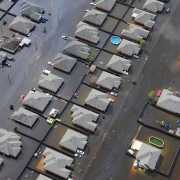Storm’s Drenching Fosters Mold Growth
ORLANDO, FL – As Floridians recover from the damage caused by Hurricane Charley they are being advised to be on the lookout for mold growth in buildings. Disaster officials caution that standing water and prolonged dampness from Charley’s heavy rains can lead to mold growth that is unhealthy for humans. Water-damaged carpets, wallboard, insulation, padding, and upholstery are materials that are favorable for mold growth. These items and other porous materials may need to be thrown away if they were saturated with water and mold has begun to grow. If wet or damp materials or areas were dried within 24-48 hours, in most cases mold will not grow.
Many different kinds of molds are part of the natural environment. Most are harmless, but some can cause hay fever-like allergies in allergic people. People who are allergic to mold and have asthma or other respiratory problems are the most seriously affected by exposure. If your home or business was water-damaged in the hurricane consider these steps to prevent or clean up mold:
- If your property was thoroughly soaked or contaminated with sewage or other wastewater, call a professional who has experience cleaning and fixing buildings damaged by contaminated water.
- If you decide to fix the building yourself, wear rubber gloves and eye protection when using bleach and make sure the area is well ventilated. Consider using an N-95 dust mask, available at many hardware stores, if heavy concentrations of mold are already growing.
- If flood-damaged carpet, pads, mattresses, upholstered furniture, drywall, or other absorbent or porous materials were not quickly and thoroughly dried, they may have to be thrown away.
- Wall studs, where wallboard has been removed, should be bleach-cleaned and allowed to dry thoroughly.
- Floors, concrete or brick walls, counter tops, plastic, glass, and other non-porous materials should be scrubbed with soap and water or with a diluted bleach solution (about one cup of bleach to one gallon of water).
- Materials that cannot be cleaned should be placed in sealed plastic bags to prevent the spread of mold spores.
If mold can be seen or smelled, the source of moisture should be eliminated and the mold cleaned up. For further information, contact the U.S. Environmental Protection Agency. The State Emergency Response Team is a collaboration of Florida’s emergency management agencies led by the state coordinating officer. It’s mission is to ensure that Florida is prepared to respond to emergencies, recover from them, and mitigate their impact.
On March 1, 2003, FEMA became part of the U.S. Department of Homeland Security. FEMA’s continuing mission within the new department is to lead the effort to prepare the nation for all hazards and effectively manage federal response and recovery efforts following any national incident. FEMA also initiates proactive mitigation activities, trains first responders, and manages the National Flood Insurance Program and the U.S. Fire Administration.







